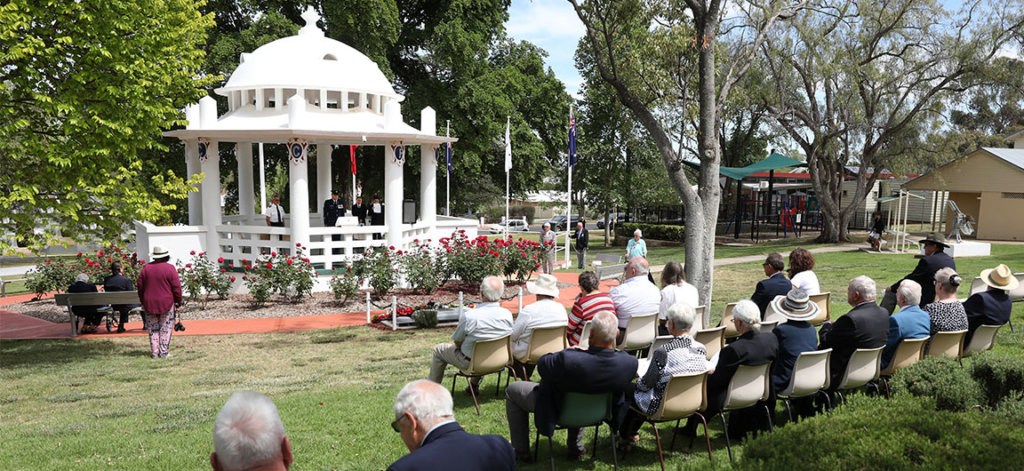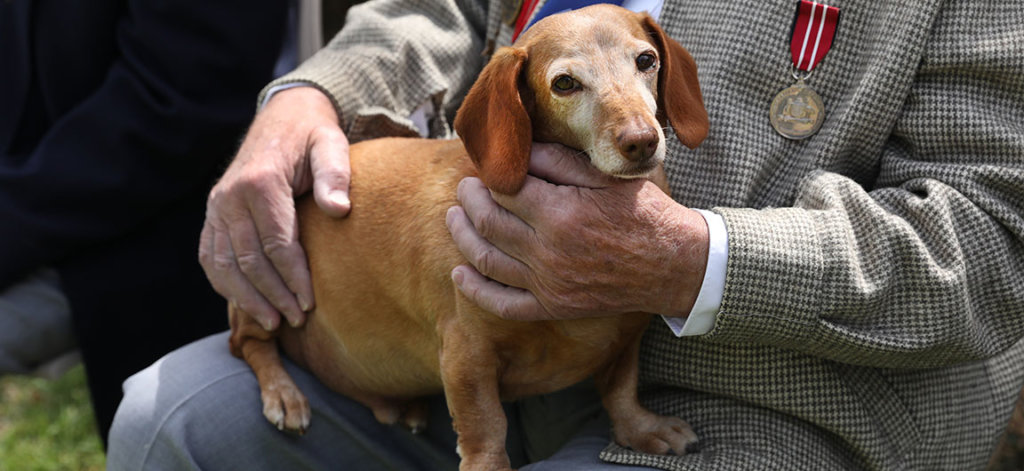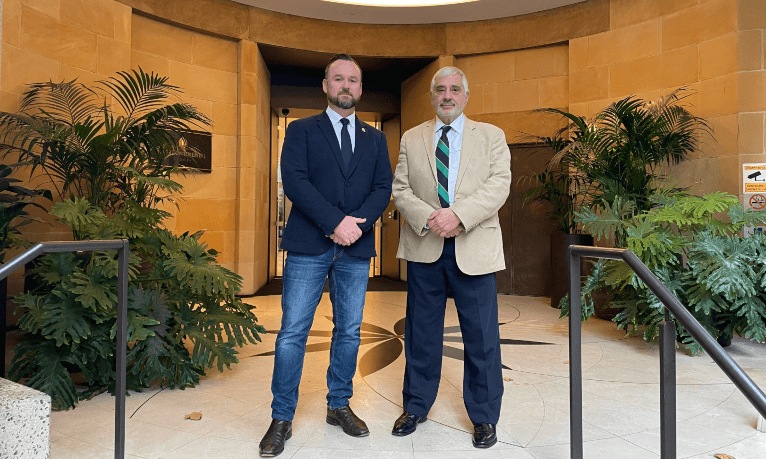Reverence & Resilience

Story by Steve Meacham. Photos by Chris Elfes. This story was originally published in the December 2019 issue of Reveille and has been adapted for publication here.
On Remembrance Day 2018, hundreds of locals crowded into Gulgong’s picturesque ANZAC Memorial Park to commemorate two significant centenaries. Exactly 100 years earlier the guns had fallen silent on the original Armistice Day, but the town had also gathered to mark the centenary of one of the most beautiful war memorials in NSW.
Gulgong District Soldiers’ Memorial, designed by Sydney architect Arthur Bates, doubles as an elegant band rotunda. Only on closer inspection do you notice its roof represents the tin hat worn by World War I Diggers.
“We believe this is the second-oldest war memorial in NSW, after the one in Newcastle,” says John Fielding, Secretary of Gulgong sub-Branch and a former Lieutenant Colonel with the Military Police. “It was begun in 1916, two years after World War I started, because local men had already died fighting overseas. It was opened in March 1918, months before the war ended.”
The rotunda is officially dedicated to “those who served in the Great War”. However, as the promises of a war to end all wars proved fanciful, it now bears multiple plaques acknowledging other wars in which Australians have fought. Partly because the historic rotunda was getting over-crowded with plaques, the sub-Branch unveiled a second war memorial a few metres away to acknowledge the Centenary of the Armistice and “to remember the fallen of all wars”.
This second memorial, dedicated on Remembrance Day last year, is a miniature replica of the one in Compiègne in France where the Armistice was signed aboard Marshal Foch’s rail carriage.
Senior Vice President of Gulgong sub-Branch Peter Leotta (“I had the most important job in the army: I was a private chef in the Catering Corps”) points out other signature features of the park.
“Look”, he says, “this thriving pine tree was planted in 2000 from a seedling taken from Lone Pine on the Gallipoli battlefield. And that bed of rosemary bushes is boomerang-shaped to honour Indigenous Australians who fought in the military.”

The Ten Dollar Town
Like the heritage-rich town in which it is situated, the park is beautifully maintained. Gulgong appeared on the back of Australia’s first $10 note, hence its nickname: the Ten Dollar Town. Today, its gold rush streetscape, museums and curiosity shops make it a tourist gem of Central West NSW. Yet – despite appearances – Gulgong and its sub-Branch have endured tough times.
“We’ve been in drought for two years and it doesn’t look like it’s getting better any time soon,” says Vietnam veteran David Henderson, who (apart from being the sub-Branch’s President for the past 25 years) raises quarterhorses with his wife, Cathy.
In such desperate times, organisations like this sub-Branch of 46 members are part of the social architecture that bind Australian communities together. However, in mid-2017 fundraising was suspended for all RSL NSW sub-Branches and Auxiliaries. In August of that year, as the Inquiry under the Charitable Fundraising Act prepared to open and Justice Patricia Bergin SC mulled, delving into sub-Branch operations, the newly appointed Board of RSL NSW (then State Council) ordered the suspension of all fundraising activities. Meat raffles, sausage sizzles, cake stalls, charity auctions and initially even the ANZAC and Poppy Appeal were off the table.
“Fundraising events like the monthly barbecue we hold at Bunnings in Mudgee are our lifeblood,” John says. “It’s how we finance the four services we run each year.” (ANZAC Day, Vietnam Veterans Day, War Widows/Indigenous Veterans Day and Remembrance Day.)
Gulgong was more fortunate than many others. As sub-Branch Treasurer Craig Holden explains, the sub-Branch rents out a house it owns for $14,000 a year. The real income is barely worth $5000 a year due to increased rates, maintenance and insurance, which is why it’s now up for sale. Still, that rental income gave the sub-Branch a lifeline that helped it endure till the fundraising suspension was lifted in June 2019.
Survival Mode
“It’s been tough,” admits Craig, who applied to join the army three times but was rejected for a spinal condition. “We had to go into survival mode, handing in our charity number, as every other sub-Branch in NSW had to.” But as soon as the suspension was lifted Gulgong’s fundraising team went back into action for the 2019 Poppy Appeal. Like many other sub-Branches across the state, it ran the local appeal to raise significant funds for RSL DefenceCare and Veteran Sport Australia in the lead-up to Remembrance Day – the 2019 service was a highlight for the town.
Les Monks – who relinquished his rank of sergeant to serve as a gunner with his mates in New Guinea in the 2/2nd Anti-Aircraft Regiment – was the last of the sub-Branch’s World War II veterans.
David, a private and forward scout in the 8th and 9th Battalions, is Gulgong’s sole survivor from the Vietnam War. “I do the funerals of all the veterans – 145 so far – whether they’re members of the sub-Branch or not,” says David. “I’m onto my third bugler because I’ve worn out two sets of lips. But Les was special, our last World War II Digger. He was 97. We all thought he’d get to 100.”
Perhaps the thing the sub-Branch executive is most proud of – apart from the support it provides to veterans and their families – is its fascinating military museum, which thrived despite the fundraising suspension.
Located in a former 19th century gold miner’s cottage owned by the commercially operated RSL club next door, the museum holds a cornucopia of military memorabilia.
“Our museum isn’t about war,” says Craig. “It’s a place of reflection. It’s about those who served their country, what they used, and what they went through.”
Some 600 uniforms, medals, posters and curios pack the museum’s three rooms, including the oldest exhibits: a saddle and pack saddle used by the 1st Australian Light Horse in World War I. There is also memorabilia from Iraq, Afghanistan and Timor‑Leste.
There’s a fourth room in the old cottage, but it’s off limits to the 40 or so visitors a week to the museum: a place where, in Peter’s words, “we veterans can come for a coffee and to chew the fat”.

Gulgong Community Unites in Remembrance
Coming together as a community to observe a minute’s silence at the 11th hour of the 11th day of the 11th month is something Australians have done in small towns and large cities since the end of World War I and the Remembrance Day tradition is still strong in Gulgong.
With a fire ban in place, this year’s Remembrance Day ceremony was held the day before New South Wales faced catastrophic bushfire conditions. “It was a simple affair but very respectful. We had about 45 people attend the ceremony at Gulgong ANZAC Memorial Park,” says John.
The start of the ceremony was marked by a recording of Big Ben chiming 11 times – a Gulgong tradition introduced a few years ago. “On the very first Armistice Day in London, Big Ben rang out 11 chimes at 11am. We’ve actually got a recording of that, so we play it at the very start of the event. We think it’s rather a nice way to start the ceremony,” says John. A bugler immediately followed with the customary playing of the Last Post at 11am.
Inviting a special guest to attend Remembrance Day and ANZAC Day ceremonies is a tradition for many sub-Branches and Gulgong is no exception. Royal New Zealand Air Force Warrant Officer Gary Clark travelled from the New Zealand High Commission in Canberra to attend the ceremony and deliver a speech at the lunch event. A return visitor who has spoken at previous events held in Gulgong, Gary spoke about the special relationship between Australian and New Zealand troops – forged on the battlefield more than a century ago.
“It’s always nice to have a member of the New Zealand Defence Force in attendance for ceremonies like this,” says John.
While the fire ban stopped the barbecue being fired up, the sub-Branch members and guests still gathered together for lunch at the local RSL club following the ceremony.
Knowing the power of connection in holding a small town together, it’s unsurprising the members of Gulgong sub-Branch aren’t content to stop there. In a region restricted by distance as much as drought, they make a supreme effort to always attend the District Council meetings, helping isolated sub-Branches stay connected and all members across Western District Council stay informed. It’s the same logic that sends them halfway over the state to congress despite commitments back in a struggling country town.
And it’s a similar story to those playing out in hundreds of small sub-Branches, whose members put camaraderie first. Ultimately, it’s what makes the League a league.







